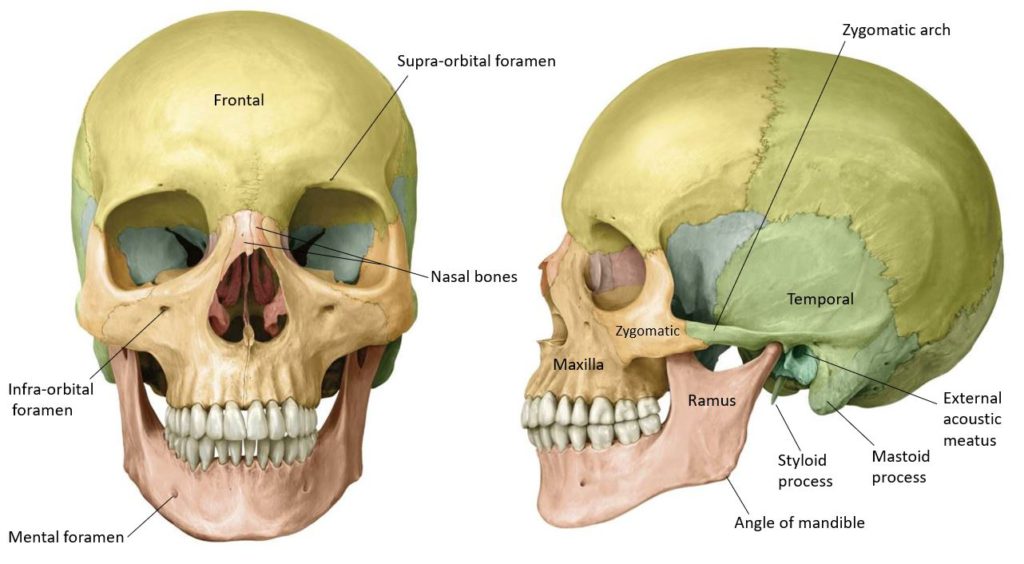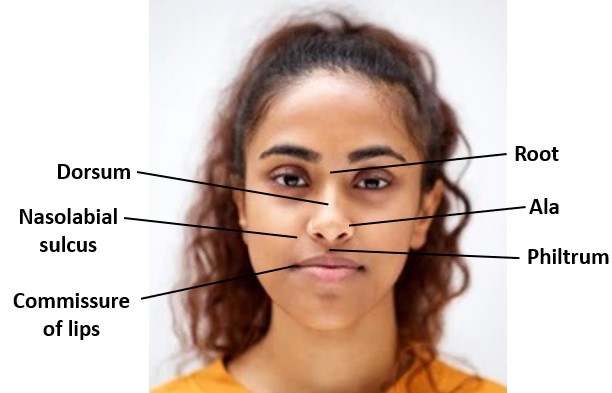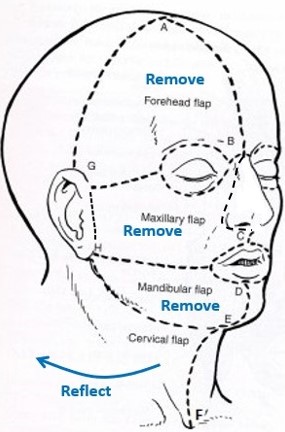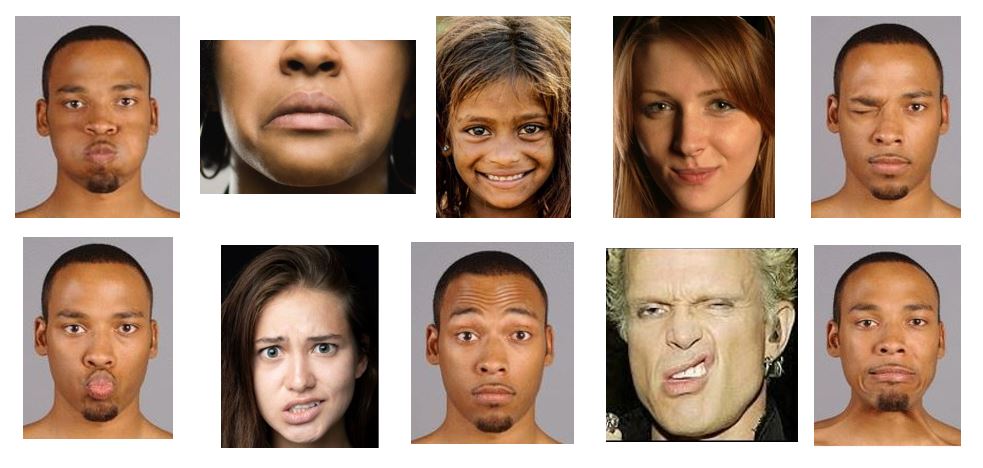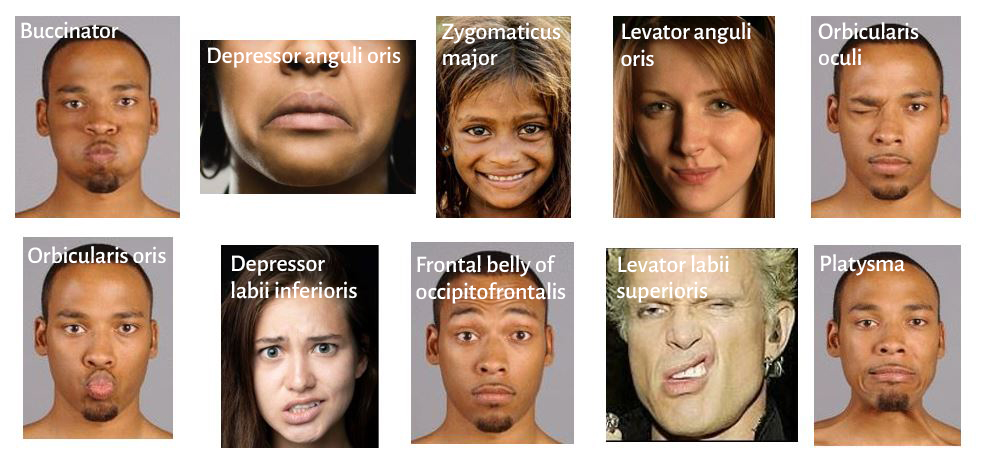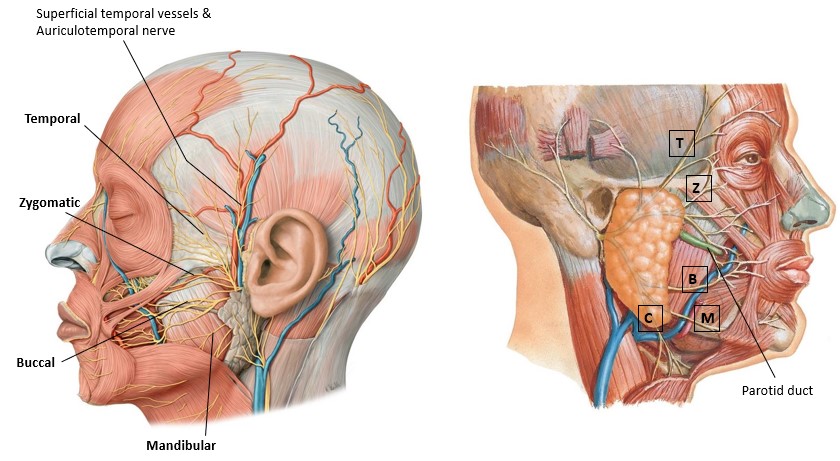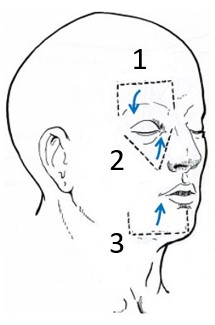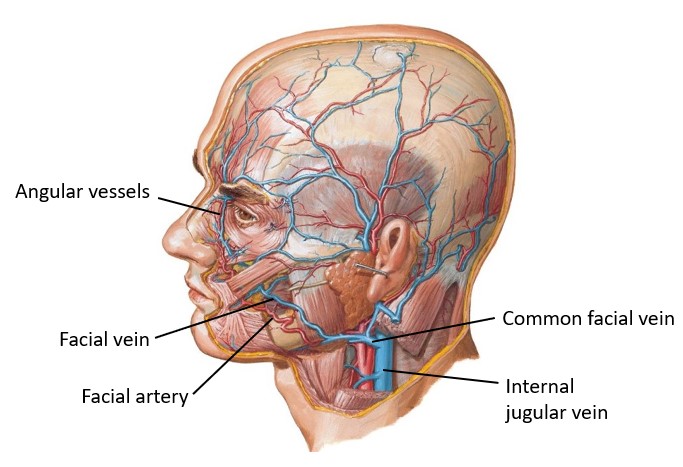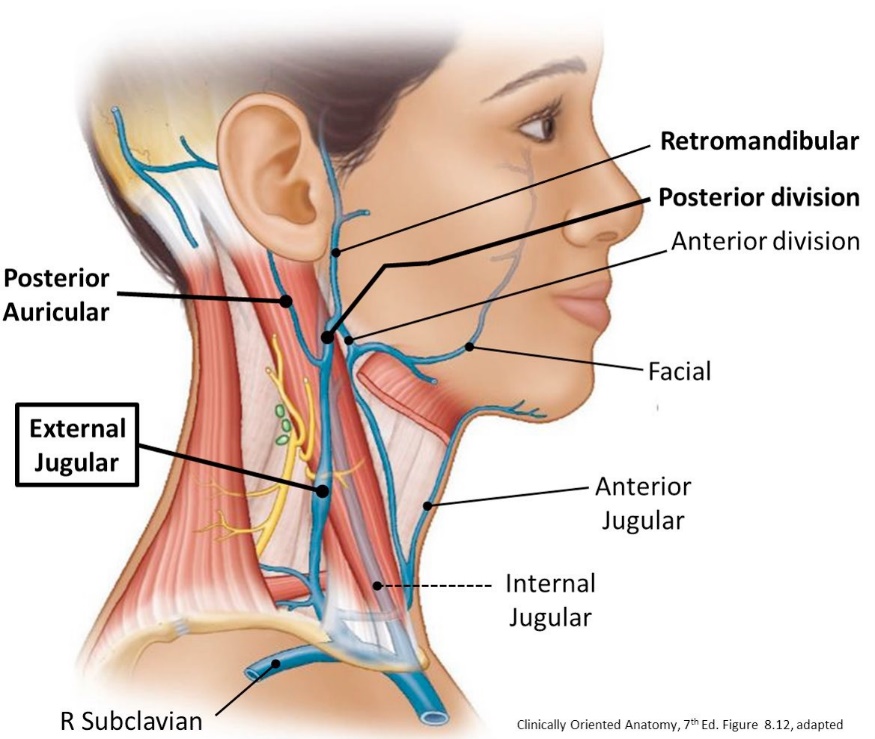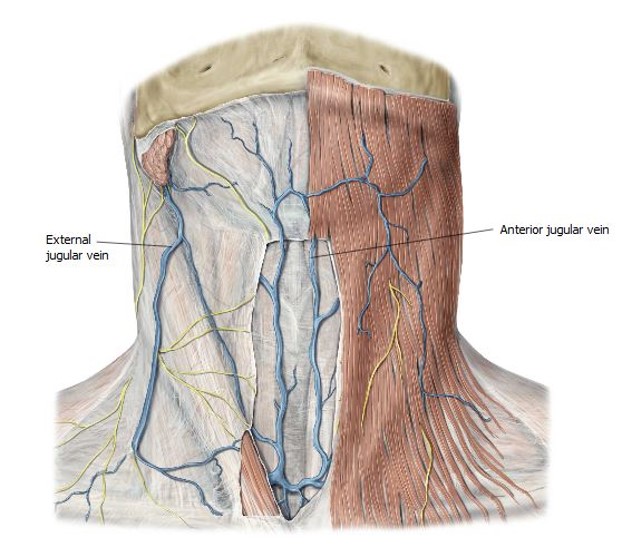1Identify the bones associated with the face and parotid gland.
2Identify surface landmarks on the face.
3Clean and identify muscles of facial expression.
4Identify branches of the facial nerve on the face.
5Locate the major sensory nerves of the face.
6Identify the facial artery and vein.
7Identify the parotid gland and parotid duct.
8Remove the parotid gland on one side; identify the nerves and vessels within the gland
9Reflect the skin from the neck and identify the platysma muscle.
10Study a prosection of the face.
Osteology
Before beginning the dissection, grab a skull and locate the following (see Figure 26.1):
■Frontal, nasal, and zygomatic bones
■Maxillae and mandible
■Orbits with supra–orbital and infra–orbital margins
■Supra–orbital notches (or foramina)
■Infra–orbital foramina
■Mental foramina
■Angles and rami of mandible
■Mastoid processes and styloid processes of the temporal bones
■Stylomastoid foramena
■Zygomatic arches
■Temporomandibular joints
■External acoustic meatuses
Facial Landmarks
On the donor, identify these landmarks on the face:
■Forehead
■Nose: root, apex (tip), dorsum (bridge), alae, nares (nostrils)
■Upper lip with philtrum (in the center)
■Lower lip
■Commissures of the lips (angles of mouth)—where the upper and lower lips meet
■Chin
■Cheeks (buccal regions) = each contains a buccal fat pad
■Nasolabial sulci—separate cheeks from lips
Dissection of the face: Prep work
Before you cut, place a plastic block under your donor’s upper back; this will allow the neck to extend back toward the table, and provide a greater area for working.
Important note
We will perform different tasks on the two sides of the face. Pay close attention to the instructions.
Both sides: Skin incisions
Using a sharp scalpel, make shallow incisions in the skin on both sides of the face and neck as shown in Figure 26.3.
Do NOT cut into the eyelids, the lips, or the nose. Make circular incisions around their margins, as shown in the figure. Do not remove the nose. We will want to study it later.
1Midline incision in forehead—down to the root of the nose (A to B). Note: The scalp has already been peeled forward, so this incision has likely been made.
2Circular incisions around the orbits, leaving the eyelids intact; then horizontal incisions from orbits to the ears (B to G). Remove the forehead flap of skin.
3Incisions around the nose, then down the midline of the philtrum (B to C)
4Incision around the oral fissure, leaving the lips intact (C to D)—then horizontal incisions from angles of mouth to mastoid processes (H)
5Midline incision from lower lip to chin (D to E)
6Incisions along edge of mandible—from chin to mastoid processes (E to H)
7Midline incision in neck, from chin to suprasternal notch (E to F)
8Vertical incision just in front of the ear (G to H)
Both sides: Skin flaps
Use a sharp scalpel to peel back the skin, from anterior to posterior—make shallow skin flaps and leave the superficial fascia intact.
This will take some time—patience is a virtue! See Figure 26.3.
1Remove the forehead, maxillary, and mandibular skin flaps.
2Reflect the skin of the neck as far posterior as possible. Leave the skin flap attached posteriorly.
Fascia of the Face
■The superficial fascia of the face is copious and unique because it contains skeletal muscles. Clinicians refer to it as the superficial muscular aponeurotic system (SMAS). Recall that skeletal muscles in other areas of the body are invested by deep fascia. The superficial fascia of the face connects the muscles of facial expression to the dermis of the skin. These muscles couldn’t produce facial expressions if they were isolated from the skin by the deep fascia.
■True deep fascia in the face invests the parotid glands and the masseter muscles.
Both sides: Clean the muscles of facial expression.
Carefully probe through and trim away the superficial fascia with scissors. Identify and clean as many muscles of facial expression (aka = mimetic muscles) as you can, concentrating on the muscles around the eyes and muscles relating to the mouth and lips. Consult Figure 26.4 below while doing this! Think about the names—they are clues to their attachments and actions.
This is a difficult task—it requires determination and patience!
The major muscles of facial expression are listed below. Examine these on a prosection as well.
■Frontal belly of occipitofrontalis (the muscle of surprise!)
■Orbicularis oculi—has two parts: orbital and palpebral (this muscle is the sphincter of the eyelids—used in the “blink” reflex)
■Zygomaticus major (smile wide!)
■Levator anguli oris (grinning muscle)
■Levator labii superioris (snarling muscle)
■Orbicularis oris (pucker up! = the sphincter of the oral fissure)
■Depressor anguli oris (frowning muscle)
■Depressor labii inferioris (muscle of disbelief!)
■Platysma—extends from the angle of mouth into the superficial fascia of the neck (grimacing muscle = tenses the skin of the neck)
■The buccinator is a muscle of facial expression (“trumpeter’s muscle” = compresses the cheeks)—we won’t see it yet since it is hidden deep to the buccal fat pad.
Both sides: Identify the parotid gland.
What kind of gland is the parotid? What does the word “parotid” mean?
■It is anterior to the ear; sandwiched between the mandible and sternocleidomastoid muscle.
■It is invested by a capsule of dense connective tissue (deep fascia).
■The parotid covers the outer surface of the masseter muscle. This muscle is a chewing muscle, not a muscle of facial expression.
Clean the surface of the parotid gland. Get a sense of its size and borders. We are now going to locate a few structures that emerge from the anterior border of the parotid.
Because these structures course transversely across the face, the fascia should be probed and cut in the same direction, NEVER VERTICALLY.
■Identify the large parotid duct (Stensen’s duct) leaving the anterior border of the gland. It runs across the masseter, parallel to the earlobe. See Figure 26.6. Trace it anteriorly until it vanishes into the buccal fat pad, then through the buccinator muscle. Sometimes the parotid duct is obscured by accessory parotid glandular tissue. Where does the parotid duct open in the oral cavity?
■Parallel and just below the parotid duct you should be able to identify a large nerve = the buccal branch of the facial nerve. There may be multiple branches.
■Parallel and superior to the parotid duct is the zygomatic branch of the facial nerve. Again, there is often more than one.
Now it’s decision time! Choose the side of the face with the best facial muscles and facial nerve branches as your Superficial Dissection. The other will be the Deep Side.
One side: Superficial dissection of the face
Do your best to clean the parotid gland. The dense fascia over the gland makes this a difficult dissection.
■Branches of the facial nerve—probe above and below the parotid duct to find the following facial nerve branches on the face (Figure 26.6):
■Temporal (to forehead)
■Zygomatic (to upper cheek, below the orbit)
■Buccal (to the fleshy central cheek)
■Mandibular (often quite thin—runs along the margin of the mandible and dives under the platysma).
■The Cervical branch descends from the lower part of the parotid into the neck, deep to the platysma. It won’t be visible right now.
Note
To remember the branches of the facial nerve on the face, try this old-school, yet catchy mnemonic: To Zanzibar By Motor Car
■Superficial temporal artery and vein: These emerge from the upper part of the parotid, anterior to the ear, and course superiorly across the “temple” region toward the scalp. Deep to the vessels is the auriculotemporal nerve, a sensory branch of V3 that supplies the scalp and ear. See Figure 26.6.
One side: Deep dissection of the face
Sensory Nerves of the Face
The skin of the face is supplied by branches of the three divisions of the trigeminal nerve. Each division supplies a characteristic swath of skin (dermatome) that reflects the embryonic development of the face (Figure 26.7). A small area of skin over the angle of the mandible is supplied by the great auricular nerve (from the cervical plexus).
Branches of CN V leave bony openings on the face and pass through the superficial fascia and facial muscles to reach the skin. Some of the facial muscles will have to be sacrificed on the deep dissection side of the face to find these nerves.
■Using a scalpel, make deep incisions in the superficial fascia and muscles of the face and reflect the flaps of tissue in the directions indicated in Figure 26.8.
Locate and clean these nerves as they emerge from the skull bones (see Figure 26.8):
1From Ophthalmic (V1): Supra-orbital nerve.
■Reflect the orbital part of the orbicularis oculi muscle downward from the forehead to find this nerve emerging from its foramen above the orbit
2From Maxillary (V2): Infra-orbital nerve.
■Make a V-shaped incision (to the bone) in the upper cheek from the medial and lateral corners of the eyelids down to an apex at the level of the nostrils
■Elevate this flap of tissue upwards toward the orbit to locate the infra-orbital nerve leaving the infra-orbital foramen. It is a large nerve.
3From Mandibular (V3): Mental nerve.
■Starting at the midpoint of the lower lip, make a deep incision (to the bone) down and then along the margin of the mandible to a location lateral to the angle of the mouth. Elevate this square flap of tissue to locate the mental nerve leaving the mental foramen.
Deep dissection of the parotid gland
The parotid has a capsule of deep fascia and the gland itself is dense and tough—so dissecting through it will be difficult. Use scissors to remove the gland in pieces.
Several structures traverse the gland in layers. From superficial to deep these are:
1Facial nerve branches
2Retromandibular vein
3Terminal part of the external carotid artery
We will tackle the first two layers in this dissection.
■The facial nerve emerges from the skull through the stylomastoid foramen, then enters the parotid gland. It typically divides into two trunks within the gland.
■From the upper trunk arise temporal and zygomatic branches
■From the lower trunk arise buccal, mandibular, and cervical branches.
Let’s find the facial nerve within the parotid gland using this method:
■First, locate the zygomatic and buccal branches above and below the parotid duct, anterior to the gland. Dissect them back to the gland, then remove pieces of the gland with forceps and scissors and follow the branches into the gland until you reach the trunks of the nerve. Follow the upper and lower trunks posteriorly to where they merge: this is the facial nerve, entering the parotid gland from the stylomastoid foramen.

■This vein is formed by the union of the superficial temporal vein (from the scalp) and maxillary vein (from the infratemporal fossa—deep to the mandible). The veins merge within the parotid gland.
Best bet: Locate the superficial temporal vein in the lower scalp and trace it down into the parotid. Remove parotid tissue as you clean the vein from superior to inferior.
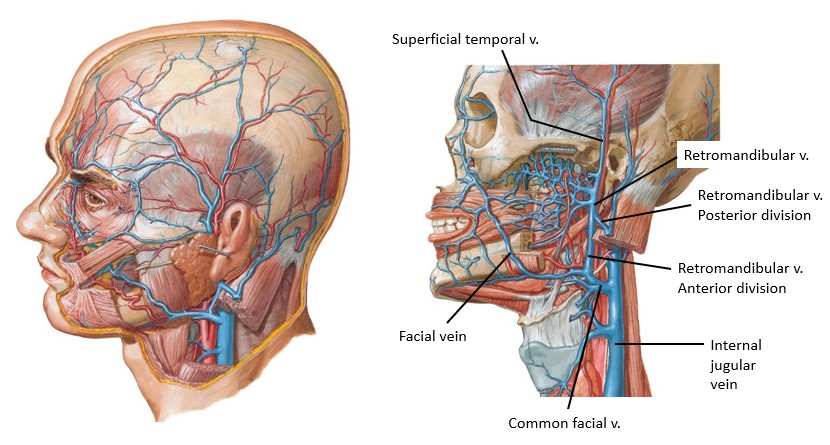
The retromandibular vein is a wide, short vein. At the inferior border of the parotid, it splits into two divisions:
■Posterior division—joins the posterior auricular vein to form the external jugular vein.
■Anterior division—joins the facial vein to form the common facial vein = a tributary of the internal jugular vein.
Facial Vessels
■The major source of blood to the face is the facial artery—a branch of the external carotid artery in the neck. The facial artery loops around the submandibular gland then curls over the mandible on to the face.
Try this
Clench your jaw and palpate the taut masseter muscle. Place a finger on the margin of the mandible just anterior to the masseter. Feel a pulse? That’s the facial artery.
■The facial artery has an oblique course across the face (Figure 26.11). It is tortuous (twisty), allowing it to have some slack when the facial muscles contract and contort the face. It winds around the facial muscles and through the buccal fat pad. When it passes lateral to the nose, it changes its name to the angular artery. The angular artery terminates at the medial corner of the eye where the upper and lower eyelids meet.
■The angular vein arises at the medial corner of the eye and descends along the nose and through the buccal fat pad. Below the nose it becomes the facial vein. It is not as tortuous as the facial artery. In the cadaver, it may be collapsed and inconspicuous. The facial vein usually joins the anterior division of the retromandibular vein to form the common facial vein.
■Identify the facial artery as it crosses the mandible anterior to the masseter. Trace it through the buccal fat pad to the angle of the mouth. Look for the inferior and superior labial arteries branching from the facial artery and entering the lips. The facial vein is usually posterior to the facial artery in the buccal fat pad.
■Remove the buccal fat. You will now be able to identify the buccinator muscle in the cheek (Figure 26.11). It is a muscle of facial expression, but also is useful when chewing, as it contracts to compress the cheeks and keep the food in your mouth between your teeth, rather than collecting in the oral vestibule.
Clinical correlation
Patients with Bell’s Palsy often lose the functions of the orbicularis oris and buccinator, in which case food may dribble from the corner of the mouth.
Both sides: Superficial neck
We will do this dissection on BOTH SIDES.
Skin incisions: If you haven’t done this yet, make a shallow midline incision from the chin to the suprasternal notch. Reflect a thin skin flap on both sides of the neck as far posterior as possible. Leave the superficial fascia.
Carefully clean the superficial fascia in the anterior neck. Identify the thin platysma muscles [platysma = flat, like the bill of a platypus]. The origins of the muscles are in the superficial fascia of the upper chest, over the clavicles. They extend upward through the neck to insert on the mandible and the angles of the mouth. Since the thoracic wall has been removed in your cadaver, you won’t be able to visualize the attachment of the platysma below.
The platysma is a muscle of facial expression, derived from the same mesoderm that forms the muscles of facial expression on the face. Like the muscles in the face, the platysma is unique in that it is located within the subcutaneous (superficial) fascia, inserts into the skin, and it is innervated by the facial nerve.
Optional dissection—if there is time.
Reflect one of the platysma muscles superiorly toward the face. Grasp the thin muscle with forceps and carefully peel it away from the subcutaneous tissue, using a scalpel or scissors. Leave the remaining superficial fascia in the neck intact.
Identify the superficial veins of the neck. These have a variable arrangement.
■Anterior jugular vein—begins just inferior to the chin, runs vertically just off the midline, ducks under the sternocleidomastoid.
■External jugular vein—arises from the posterior division of the retromandibular vein near the angle of the mandible. Descends across the external surface of the sternocleidomastoid muscle toward the midpoint of the clavicle. It is a tributary of the subclavian vein.
Clinical correlation
Patients with heart problems often have distended neck veins—some donors may have large veins with clotted blood.
Checklist, Lab #26
Review and make sure you have identified each of the structures below.
Osteology
See the list of relevant bony structures in the Osteology section above.
Facial Landmarks
See the list of landmarks in the Facial Landmarks section above.
Muscles
Identify as many of these as possible in your donor or other student dissections. Look at the prosection for help.
Frontal belly of occipitofrontalis
Orbicularis oculi (orbital and palpebral portions)
Zygomaticus major
Orbicularis oris
Levator labii superioris
Levator anguli oris
Depressor labii inferioris
Depressor anguli oris
Buccinator & Buccal fat pad
Platysma
Masseter (this is a chewing muscle on the face—not a muscle of facial expression)
Parotid
Parotid gland and duct
Vessels
Facial artery & angular artery
Wishlist: Superior and inferior labial arteries
Facial vein and angular vein
Superficial temporal artery and vein
Retromandibular vein
Nerves
Temporal, zygomatic, buccal, mandibular, and cervical branches of VII (see prosection if you can’t find them—the cervical branch is tough to find)
Supra-orbital nerve (from V1)
Infra-orbital nerve (from V2)
Mental nerve (From V3)
Wishlist: Auriculotemporal nerve (from V3)
Superficial Neck
Platysma muscle
External jugular vein
